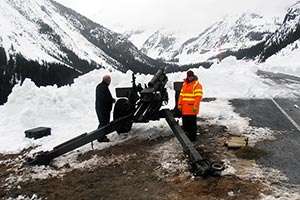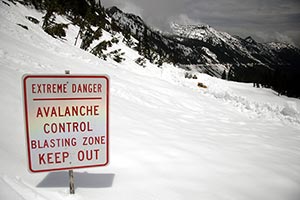How Washington DOT Uses Bombs, a Howitzer and an M60 Tank to Keep the Roads Open

 WSDOT/Flickr
WSDOT/FlickrSNOQUALMIE PASS, Wash. — John Stimberis’ office looks nothing like that of a typical state employee.
Sure, there’s an ancient coffee pot in the corner, cheap carpet and old computers humming quietly.
But you’re also liable to trip over a stray pair of ski boots, and pasted to a glass door is a bumper sticker that reads: “There are very few problems which cannot be solved by the suitable application of high explosives.” The other tools of his trade include skis, snowmobiles, Sno-Cats and an M60 tank.
Stimberis, 47, is one of two avalanche forecaster supervisors working for the Washington State Department of Transportation.
His day starts at 5:30 a.m., and before most people have even contemplated a cup of coffee, Stimberis is formulating a battle plan to protect the 28,000 vehicles that travel over Snoqualmie Pass each weekday — double that on weekends — from avalanches. It’s a job that’s equal parts prognostication, planning and pyrotechnics.
Nearly two hours before sunrise on a recent morning, Stimberis was tramping through several inches of fresh powder at WSDOT’s Snoqualmie Pass snow study area, a flat plot of land with a weather station and space to dig.
First, Stimberis grabbed a bucket of new snow to weigh. He checked various temperature sensors and recorded height measurements to catalog new snowfall.
Moments later, he was knee-deep in snow, digging a pit with a compact shovel and using a snow saw to cut out a column.
An even cut across the snow’s face will reveal weak layers in the snow, which might present an avalanche hazard. A compression test of the column will determine how likely the layers are to separate.
“There’s a potential avalanche layer, for sure,” Stimberis says, noting a layer created by freezing rain and another by surface hoar, or, in laymen’s terms, a gnarly frost.
 WSDOT/Flickr
WSDOT/FlickrStimberis relies on caffeine, boyish energy and decades of plodding in the snow as a ski patroller and avalanche expert to keep Interstate 90 travelers safe from the 30 avalanche tracks that line Snoqualmie Pass.
His arsenal includes the aforementioned tank, a howitzer and hundreds of pounds of explosives.
The forecast might be his most important weapon. Weather stations Stimberis maintains in partnership with the Northwest Avalanche Center ping observations to his office throughout the day.
But it’s not the artillery that gets Stimberis out of bed at 4 each morning.
“I just love snow. Love skiing on it, love shoveling it … even seeing a plow pushing it,” he said.
His fascination began at 15 when Stimberis moved from Southern California to Vancouver, Washington. He immediately took up skiing and began venturing into the backcountry.
While attending Central Washington University, Stimberis studied geography but lacked academic focus until a professor advised him to take winters off. Skiing was interfering with school.
During winters, Stimberis lived a ski bum’s life out of a 1975 Volkswagen camper van. He befriended the ski patrollers.
He graduated in 1992 and soon took a job as a professional ski patroller and avalanche controller at the Alpental ski area at Snoqualmie Pass.
That’s when he was bitten by the avalanche bug.
At just over 3,000 feet, warm western air and cold eastern flow constantly battle for supremacy at the pass. With Alpental’s steep slopes, quick swings in temperature make for a compelling avalanche problem.
“It’s in your face,” said Rob Gibson, the Ski Patrol director for Snoqualmie Pass ski areas.
Avalanche problems elsewhere often develop over time. Not at Alpental.
 Avalanche crew prepares detonation cord. WSDOT/Flickr
Avalanche crew prepares detonation cord. WSDOT/Flickr“Fluctuating temperature back and forth, rain on snow — that makes it a real-time, right-now problem,” Gibson said.
In 1999, Stimberis began work full time at WSDOT. In 2011, he became the program’s supervisor, the culmination of his decadeslong apprenticeship in the art and science of snow.
“You have to take what you learned in the field and apply it to slopes 1,000 feet above and miles away,” Stimberis said of his WSDOT job. “These lessons don’t fall on you in one season. It takes time.”
Commerce along the I-90 corridor hangs on Stimberis’ decisions. Safety, too.
“I won’t say there’s pressure to have it [I-90] open 24/7, but it’s unspoken. It’s the primary route, we need to have it open,” Gibson said.
Recently, freezing rain forced an overnight closure by felling more than 30 trees onto the roadway and making it unsafe for vehicles — or WSDOT crews — to travel Snoqualmie Pass.
Closures are costly. After a four-day halt to traffic on I-90 in 2008, a WSDOT study found the economic impact of the highway’s shutdown was about $28 million.
Ultimately, the decision “is always based on safety,” Stimberis said. “We can’t eliminate all risk … but we do our best.”
In winter, Stimberis has his eye on about five avalanche-prone areas at Snoqualmie Pass. They feature about 30 avalanche tracks, which vary widely in size and slide frequency.
When avalanche danger rises and the highway must close, WSDOT crews first clear out all vehicles.
Then, bombing can begin.
Each of the five areas has its own prescribed treatment.
Preventive work, such as nets rigged along cliff sides, takes care of some slopes. On others, including Granite Mountain, avalanche-start zones are too difficult to access in the winter and require artillery fire from the M60, with the howitzer serving in relief duty. Both fire explosive shells that weigh 5 to 7 pounds, Stimberis said.
 WSDOT/Flickr
WSDOT/FlickrSome slopes, such as the south side of “Airplane Curve,” are bombed with avalanche-triggering explosive sacks hung from cable trams.
In the 1990s, WSDOT built these mechanical trams to haul explosives up parts of the mountain that aren’t accessible. At Airplane Curve, a 25-foot tower rises next to the highway. Atop the tower is a tarp-covered platform.
A stationary bike rigged with a steel cable sits inside the covering. With 125 rotations of the pedals, Stimberis’ crew can haul a 26-pound explosive sack up to a snow-loaded cliff above the avalanche-prone slope.
The sack, which is filled with an industrial explosive, is trailed by a detonating cord and suspended from a chain. Once the sack is a few feet from the snow, Stimberis’ crew detonates the bomb, wiping the slope of unstable snow and removing possible danger to the roadway.
Fewer bombs are needed at the pass these days, though.
In the so-called “East Shed” area, a recently constructed avalanche bridge sits next to Lake Keechelus.
The area was once responsible for about 75% of avalanche control work, Stimberis said. Natural slides now flow underneath the elevated highway.
On the surface, the pressures of Stimberis’ job seem to glide right past him.
With locks of flowing hair that sprout from beneath a blue knit cap, he still resembles a chilled-out ski bum. Doing himself no favors with stereotypes, Stimberis has seen Phish, his favorite band, almost 150 times.
But behind the mellow vibe is a steady practitioner, colleagues said.
“He’s a very even-keel guy,” said Kenny Kramer, director of the Northwest Avalanche Center.
In summers, Stimberis runs ultramarathons.
“Once he grabs onto something, he gives it his all,” said Gibson, the Ski Patrol director.
That’s his approach to avalanche work, too. During snow-dumping winter storms, Stimberis often sleeps at the office, he said. The forecast — and any changes — are rarely off his mind.
“Oftentimes when I wake up in the course of the night, I’ll look [at weather conditions],” Stimberis said.
When winter ends, the real fun begins. In April, as Snoqualmie’s snowpack melts, Stimberis’ crew of four or five will turn its attention to Chinook Pass, which is about 2,400 feet higher. Highway 410 runs through about 100 avalanche paths, Stimberis said.
His crew of skiers trigger avalanches before maintenance crews enter the area to plow away snow from the closed highway.
The steep terrain requires Stimberis and his crew to travel on backcountry skis. Instead of exploding bombs above the surface, they bury the explosives in the snowpack to shatter snow slabs, or traverse slopes to “ski cut” and send avalanches down.
Spring weather can change almost instantly, and it takes a cool head and seasoned ski skills to stay safe, said Gibson, who helps the highway program part time.
He and Stimberis once got caught in a fast-moving thundersnow storm, he recalled.
“We were skiing with explosives on our backs and lightning was striking around us,” Gibson said. “We were skiing this crazy terrain.”
Few highway programs offer work that close to the snow, Stimberis said.
It can be a thrill to send a freight train of snow down to the road below.
“It sounds like a wave crashing against a wall,” Stimberis said.
Each attempt is a measure of his experience.
“It’s that moment you get to test your hypotheses and everything you know about the snowpack.”


